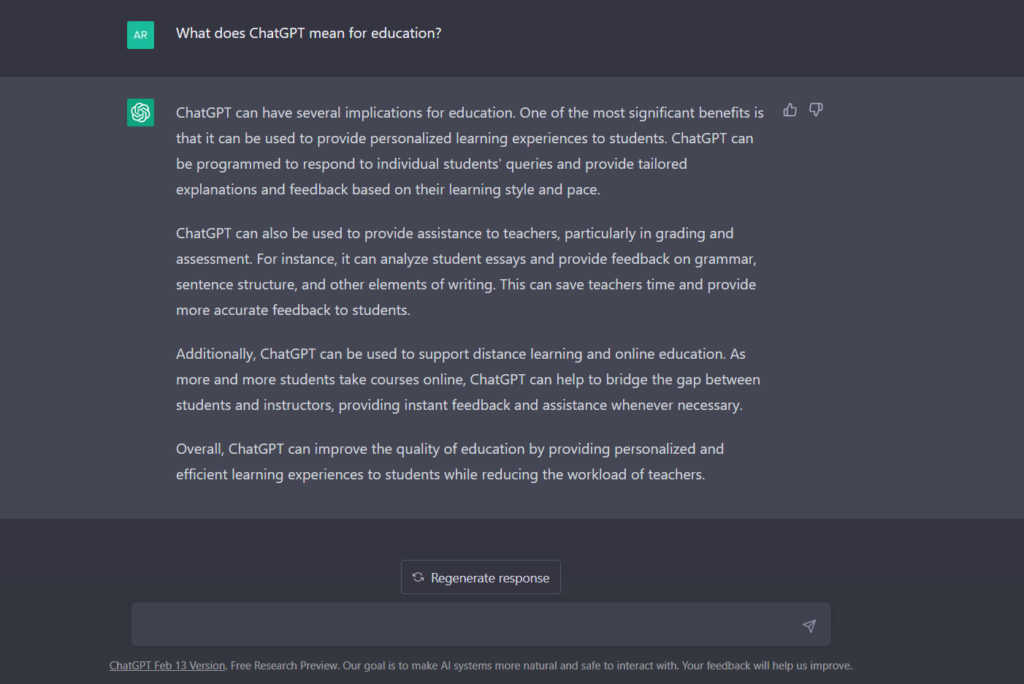Whenever a new technology reaches the mainstream of society, we wonder about its potential impact on education. Such worry has followed the introduction of new technologies at least as far back as the printing press. ChatGPT is the latest technology making headlines in the education world. Many observes have speculated about the potential impact of ChatGPT and related technologies have for teachers and students. This post offers a basic introduction to ChatGPT and an overview of the conversation surrounding it.
What is ChatGPT?
Released in November 2022, ChatGPT is an artificial intelligence (AI) chatbot developed by OpenAI. ChatGPT can write and edit text in response to prompts given to it by the user. ChatGPT was trained using data collected from the internet, and then refined through human demonstrations that help the technology to model human-like language behaviors. The tool does not have a “live” connection to the internet and its base of knowledge extends only through 2021. Still, its ability to answer questions, engage in conversation, and generate compelling arguments have astounded many and revealed just how advanced commercial AI technology is today.
ChatGPT, and AI technology in general, pose several ethical questions, sparking debate and questions about how these technologies fit in the educational world, and if they even belong in the classroom.
What are the concerns?
One of the biggest concerns with ChatGPT is plagiarism. If a student can simply type in an essay prompt and get back an entire paper, what is to stop them from doing so?
This leads to worries about students’ loss of critical thinking skills as well as creativity. If the bot does our thinking for us, what will stop students from letting ChatGPT solve all of their homework, causing their ability to think for themselves to deteriorate? It could also cause a lack of motivation among students if they know that their work could be done for them by a bot in a fraction of the time it would normally take them.
Beyond these concerns are some of the flaws within ChatGPT that students have already identified through an interview conducted by the New York Times.
A lot of students have identified inconsistencies with ChatGPT, in which the bot gives different answers after being asked the same questions. The tool was trained on data available in 2021, and has not been updated since, resulting in incomplete or out of date information.
Scholars at the University of Minnesota Law recently conducted research by having the bot go through Law School. The bot passed the program with a C+ average. While it was able to earn a passing grade, the experiment displays that ChatGPT’s knowledge is basic and lacks the critical skills and knowledge often required for a paper. If students utilize ChatGPT for information purposes, they will not be getting the best, most up-to-date information required to excel in a class.
What are the potential benefits?
With all of these flaws in ChatGPT, one has to wonder, are there any upsides to it in the world of education?
Many have remarked that ChaptGPT is a wake-up call for educators to reexamine their pedagogy. ChatGPT alerts educators to analyze how they give their exams and assignments. Do they mostly use memorization and recall as a way to assess comprehension, or do they actually challenge their students to think critically?
ChatGPT can help educators to change and challenge their own curriculum by thinking about how easy it would be for the bot to complete an assignment. It allows for teachers to think about possible solutions to the problem posed by ChatGPT. For example, should educators rethink essay prompts, making students incorporate their own personal experiences into papers to avoid plagiarism?
Artificial intelligence could be a great opportunity for educators to revamp their assignments, shaping them for the ever-changing world and getting educators to ask themselves what their assignments are really teaching students to do.
How do educators work with ChatGPT?
Another issue with ChatGPT is how fast technology changes. How can educators incorporate ChatGPT into their classrooms if its information and technology might be obsolete in a matter of months?
Many educators have started to look at they can work with AI instead of working around it. This could involve having students input a prompt into ChatGPT and then analyzing the text the bot produces, critiquing the strengths and weaknesses of its response. It is a matter of looking at the flaws within AI technology and helping to make students aware of them. After all, artificial intelligence is unlikely to disappear. Indeed, we can expect it to improve and become more sophisticated with time.
Technology is constantly changing, and if we teach students how to work with AI and how to be critical of it instead of fearing it, in the end we can strengthen the skills of students instead of losing them.
Where can educators find advice on navigating the world of AI ?
Given the rapid emergence of ChatGPT, this list is sure to grow and evolve. Here are some resources from Common Sense Media to get started:
- Guide to ChatGPT for Parents and Caregivers
How the artificial intelligence (AI) tool works, and how to talk with kids about it. - Artificial Intelligence: Is It Plagiarism?
A lesson plan for engaging students in Grades 9-12 in critical discourse, using AI as the subject. - ChatGPT and Beyond: How to Handle AI in Schools
A round up of advice and guidance for educators as AI technology evolves and makes its way into classrooms.
A Study.com article, ChatGPT-4’s SAT Score Improvement Prompts Discussion on Incorporating Responsible AI in Curricula delves into further into topics discussed in this article.
